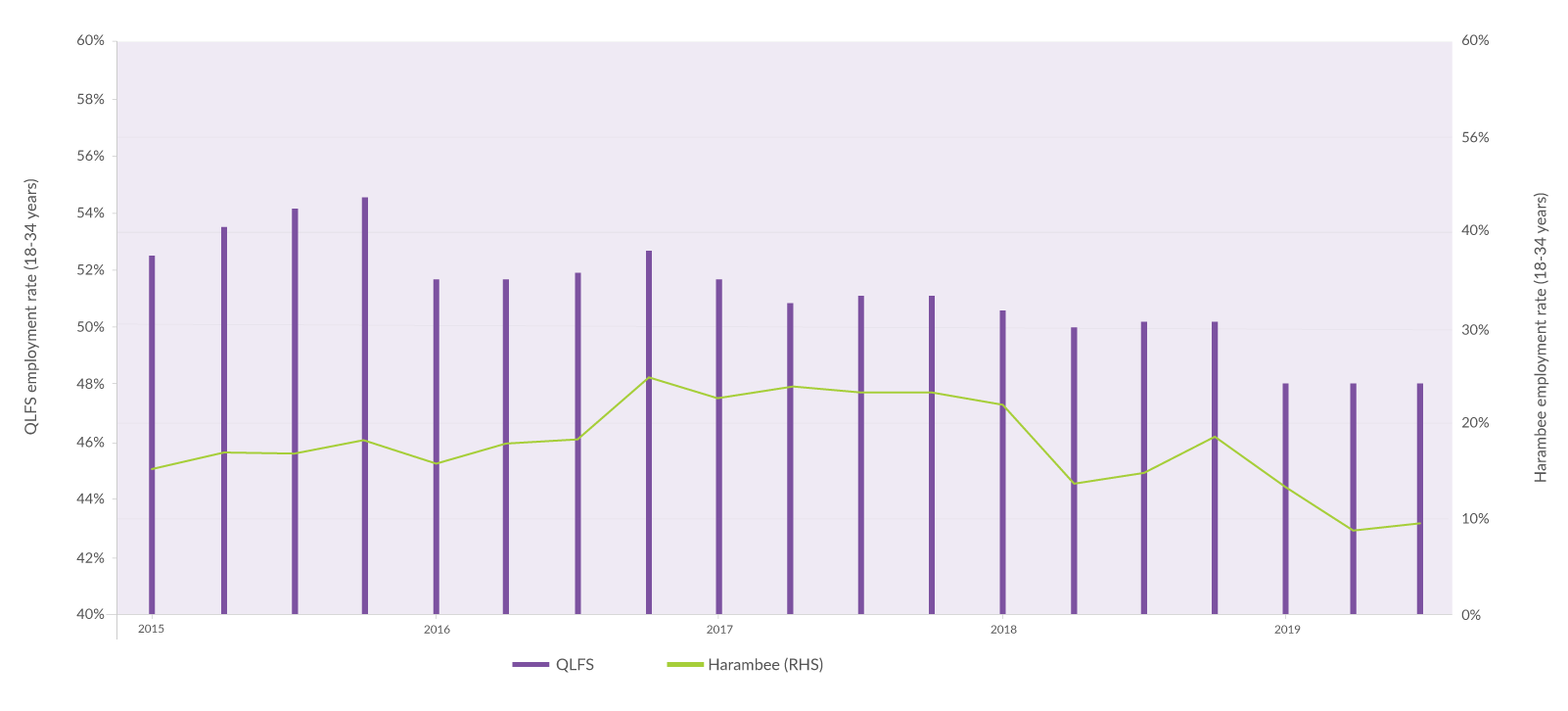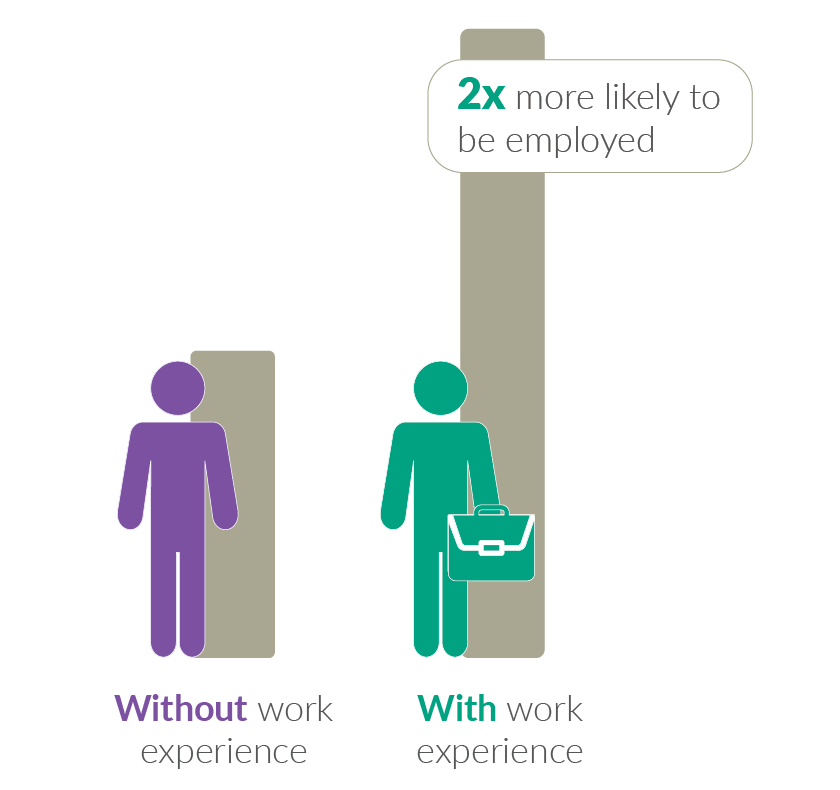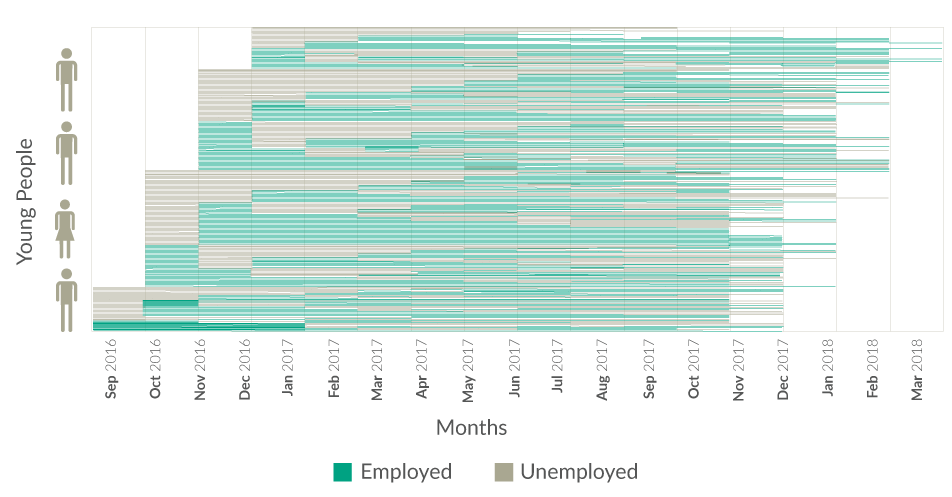BREAKING
BARRIERS
OCTOBER 2019
Quarterly Employment Report
October 2019
Recent research, however, shows this is not the case. First time work-seekers, especially those from poor households, are rarely securing long-term, permanent employment. This research suggests that getting a first job does not guarantee a move into ongoing and stable employment. Young people are often in for bumpy ride as they enter in, fall out of, and bounce back into the labour market.
This poses policy and on-the-ground challenges of equipping young people to ‘bounce back’ into the next opportunity when a short-term work experience comes to an end. The evidence shows that this is much harder for first-time work-seekers as compared to those with prior experience.
This edition of Breaking Barriers explores this bumpy ride. It draws on evidence from four data sets: (1) Harambee’s engagement with a network of over 650,000 young work-seekers, (2) longitudinal analyses from the South Africa National Income Dynamics Study (NIDS), (3) taxpayer data from the South African government’s National Treasury, and (4) a recent study completed by Eliana Carranza (World Bank), Rob Garlick (Duke University), Kate Orkin (Oxford University), and Neil Rankin (Stellenbosch), in collaboration with the Abdul Latif Jameel Poverty Action Lab Africa office.




YOUTH EMPLOYMENT
TRENDS
Statistics South Africa’s Quarterly Labour Force Survey (QLFS) employment rate for youth (18 – 34 year olds) fell to 47,7% – the lowest in four years. Harambee’s employment rate increased to 9% this quarter; in part driven by increased hiring for jobs in retail and hospitality ahead of the summer holidays in South Africa. This however is a very modest improvement from the previous quarter, and is not enough to absorb the 2.3% increase in unemployed youth and 2% increase in discouraged work-seekers.
Harambee* and QLFS** youth employment rates

*The Harambee employment rate is measured up to 30 September 2019. Data is not drawn from Stats SA data but reflects a sample of youth who are typically living in grant dependent households.
**Youth includes all 18 – 34-year olds
***Note: Harambee’s employment rate is lower, because representatively our sample has traditionally focused on urban youth and more formal opportunities. However our model data collected is shifting to account for the high mobility of youth in and out of urban areas, as well as the changing nature of work.
KEY INSIGHTS FOR
THIS QUARTER
Opportunities for permanent jobs are very limited in the South African labour market
In tracking the employment journeys of young people over time, a Harambee analysis for 150,000 work-seekers finds that typically only one in five find work that is longer than three months in duration. An additional one in four find erratic work that is of an even shorter duration.
This insight is supported by company data submitted to the South African Revenue Services on the income tax that they pay for employees which shows that only half of annually registered jobs are “stable” from one year to the next (i.e. the person who has a job was in it in the previous year and will continue to be in it in the current year.) We see that less stable jobs are characterised by lower levels of pay and accessed by youth with fewer skills and experience.
Figure 1: Only one in five young work-seekers find work longer than 3 months in duration

Source: Harambee Youth Employment Accelerator 2019
Prior experience helps in securing on-going work
The longitudinal National Income Dynamics Study finds that having some work experience more than doubles the likelihood of being employed for more frequent durations. It also finds that a work-seeker who is young, female, and from a poor household or lives in rural area, has less than a 25% chance of finding sustained employment without some prior work experience. This is as compared to males from urban areas with more household income who have a 37% chance in comparison.
The NIDS data shows that other factors can count, too. Access to household income (which can support the costs of job search) increases the likelihood of being in a job for longer than three months by 5%. Harambee’s data shows that good communication scores on assessments increases the likelihood of being in a job for longer than 3 months by 4%.
Figure 2: Having some work experience more than doubles a young work-seeker’s likelihood of being employed

Source: Measuring employment volatility in South Africa using NIDS: 2008–2017,
(Zizzamia & Ranchod)
We need a shift in policy and research to focus on how young people ‘bounce back’ from recurring periods of unemployment
The realities of a rapidly changing labour market is no longer just about getting young people into a first job. We must support the conditions for them to remain employed, and more importantly, understand the interventions required to help them bounce back when they fall back into unemployment. More research is required in this area as well as policy interventions that better respond to the realities of young people regularly bouncing in and out of work.

Source: Based on research conducted by Eliana Carranza (World Bank), Rob Garlick (Duke University), Kate Orkin (Oxford University), and Neil Rankin (Stellenbosch), in collaboration with the Abdul Latif Jameel Poverty Action Lab Africa office
Solutions are needed to ‘bounce’ young people from one work opportunity to the next
Pathway management platforms – which support young people beyond just a match to a job – are needed to catch young people when they are out of employment, education, and training systems. A holistic approach to pathway management can improve young people’s ability to see what can come next and how they can get there. The Presidential Jobs Summit adopted Harambee’s Pathway Manager as a national solution that can partner with others to create opportunities for unemployed youth across the formal and informal economy.

Source: Harambee Youth Employment Accelerator 2019
YOUTH VOICES
SOLUTIONS
What can government do?
- Scale pathway management platforms that are accessible to all young people entering the labour market each year that can provide support to assess and signal young people’s potential
- Implement the ‘no-experience required’ policy
What can young people do?
- Learn as much as possible from ALL work experiences and understand how you can apply the skills in different contexts
- Get references from supervisors where you have had work experience including volunteering opportunities
- Stay in touch with the networks from all your work experiences
What can employers do?
- Provide reference letters that speak to the work experience a young person has gained
- Open their networks and opportunities in other parts of their businesses to work-seekers when short-term contracts end
- Structure internships and learnerships to provide meaningful work experience that add employability to the CV of the work-seeker
- Provide vocational support to young hires whilst in work in anticipation of their need to be looking for work again (e.g. brushing up interview skills, updating CVs)
- Consider allowing young hires some time towards the ends of contracts to begin looking for other work to help them ‘trampoline’ to the next opportunity
- Link young work-seekers to pathway management platforms such as Harambee, that can link young people to opportunities
- Provide mentorship and coaching to young hires during the first few months of work to improve their retention in the job
- Offer training during employment to new hires that will be valuable to securing their next job
- Be sensitive to the challenges that young first-time work-seekers face when they first find work (such as having money for transport to get to work in the first week/month) – this can help improve their retention in the job
- Review the length of contracts on offer and whether their duration can be extended or renewed, to improve the work experience a young work-seeker can attain





 Stay Connected
Stay Connected

